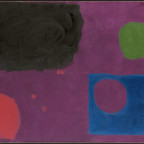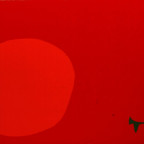Biography
Waddington Custot Galleries presents Vibration of Space, an exhibition examining the artistic exchange between British painter Patrick Heron (1920–1999) and the non-figurative painters of post-war Paris. Spanning the years 1945–65, the exhibition highlights Heron’s admiration of three artists in particular: Nicolas de Staël (1914–55), Hans Hartung (1904–89) and Pierre Soulages (b. 1919). The exhibition will focus on this overlooked dialogue between European and British artists in the post-war years, a period dominated by the emergence of American Abstract Expressionism.
Heron’s interest in the Parisian art scene began in 1949 when he saw paintings by Soulages at the Salon de Mai. A couple of years later, in 1951, Heron visited the de Staël exhibition held at Matthiesen’s Gallery in London and this proved to be a turning point in his career. The current exhibition includes Heron’s first abstract painting ‘Square Leaves (Abstract) : July 1952’, which echoes de Staël’s ‘little squares or oblongs of thick, brushed paint’.[1]
Vibration of Space takes as its starting point Heron’s essay Space in Painting and Architecture (1953) in which he argued that by 1950, non-figurative painting in Paris had become the most significant movement in French art since Cubism. For Heron, space became the medium itself. He cited Soulages in particular for acknowledging and manipulating the illusory sense of space which existed within the flat surface of a painting, as compared to the pre-war artists who denied its presence. The materiality of paint is acknowledged and its application producing a visible grain on the painting’s surface. Heron believed this created a ‘vibration of space’, a key element which he brought to his own work of this period and valued so much in the work of Hartung, Soulages and de Staël.
Heron began writing about art from the mid-1940s, contributing to The New English Weekly and later becoming the art critic for The New Statesman and Nation and London correspondent for Arts Digest. Heron’s prolific writing on these artists gave the Parisian painters a voice in London. After Heron sent photographs of his own work to Soulages, Soulages replied, ‘This photograph has increased my understanding of your interest in space and its prominent role in your reflections on painting. By the way, I agree with you on this point entirely, which makes what you write about my painting all the more meaningful’.[2]
Heron’s move toward pure abstraction began around 1952, but it was not until the mid-fifties that his artistic style changed completely. He presented his stripe paintings, the first of their kind, at a group show in 1957 at The Redfern Gallery. Despite being heavily criticised at the time, these have since become hugely influential. Small Red Verticals : March 1957 and Vertical Stripes : 1956 are included in Waddington Custot Galleries’ exhibition and are early examples of Heron’s use of this revolutionary motif.
In 1968, Alan Bowness (Director of Tate 1980–1988) recognised that the, ‘very unpopular strand which the vertical paintings represented in 1957 has been seen to be a central issue to the development of painting in our time.’[3] Heron’s controversial early adoption and championing of this form of painting, demonstrates his importance in both the history of European post-war art and within twentieth century art criticism.
Notes to Editors
About Patrick Heron
Patrick Heron (b. 1920 Leeds, England; d. 1999, St Ives, England) was a British artist and critic recognised as one of the leading painters of the St Ives School. Through his art and writing, Heron made a large contribution to the dissemination of modernist ideas in post-war Britain. Heron studied at the Slade School of Fine Art, London, between 1937 and 1939. The 1946 exhibition of Braque's work at the Tate Gallery profoundly influenced Heron; he would write a book on Braque in 1956. The Redfern Gallery hosted Heron's first solo exhibition in 1947; his first solo exhibition in New York was held at the Bertha Schaefer Gallery in 1960. In 1956, Heron moved to Zennor, Cornwall, where he lived until his death, and began making abstract work inspired by tachisme and Abstract Expressionism. In his famous lecture The Shape of Colour (1973), Heron argued that colour and shape were inseparable from each other, an ambition that defined much of Heron's work.
From 1980 to 1987, he was a Trustee of the Tate Gallery, London. He received Honorary Doctorates from Exeter and Kent Universities, Winchester School of Art and the Royal College of Art, London, amongst others. Heron won the Grand Prize at the John Moores Prize Exhibition in Liverpool in 1959 and the silver medal at the São Paulo Art Biennial in 1965. He held retrospective exhibitions at the Whitechapel Art Gallery in 1972 and at the Barbican Art Gallery in 1985. A major retrospective of Heron's work was organised by the Tate Gallery, London in 1998.
[1] Nicolas de Staël, 3 May 1956, The Listener reprinted in Painter as Critic edited by Mel Gooding, TATE, pg 109–11
[2] Letter from Pierre Soulages to Patrick Heron, 3 November 1953 (supplied by the Heron Estate)
[3] On Patrick Heron’s Striped Paintings by Alan Bowness, 1968, Patrick Heron, Byatt, Gayford and Sylvester, Tate Gallery Publishing, pg. 136.










